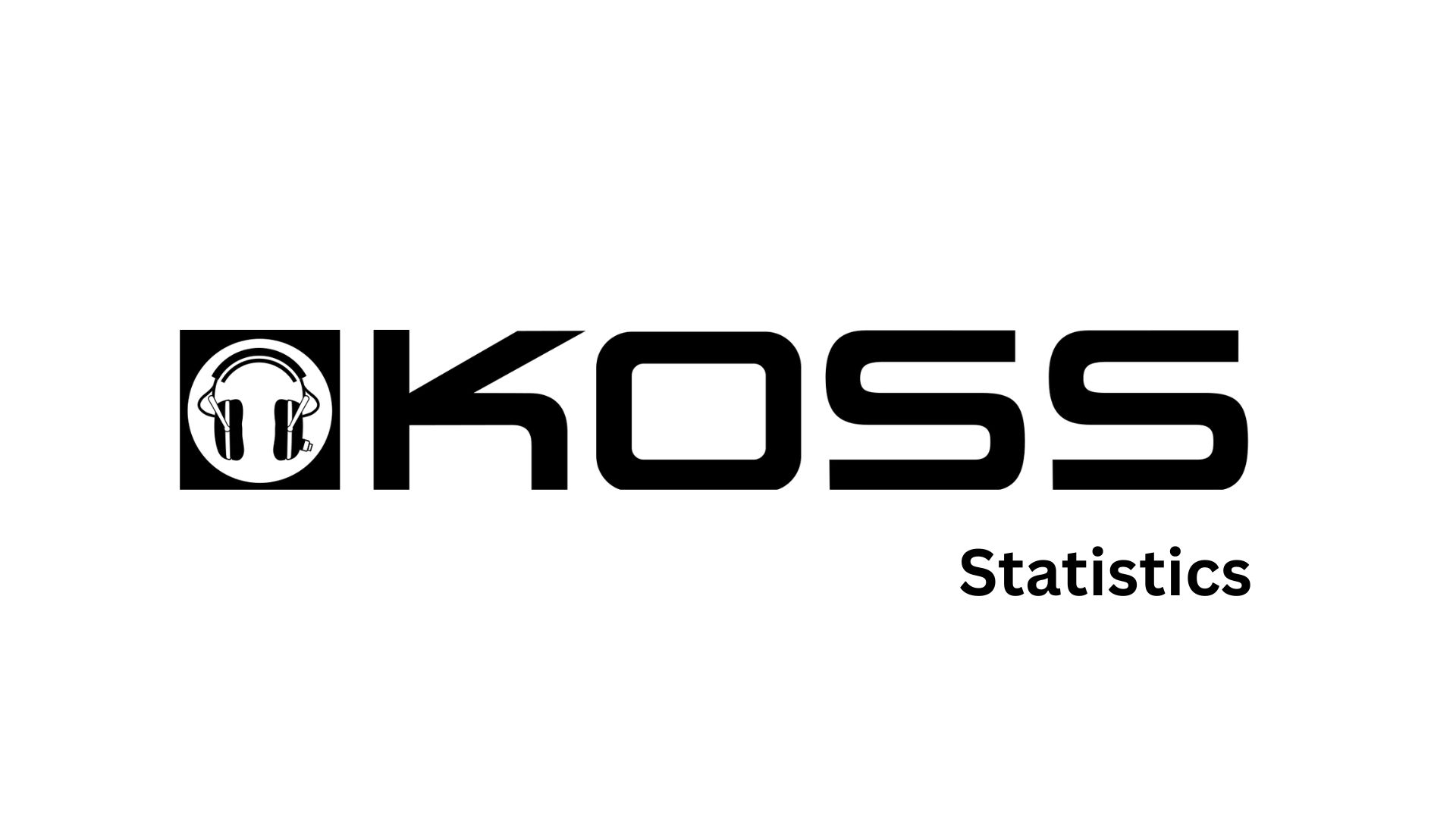Collaborative Robots Statistics By Market Size, Revenue, Sales And Cost (2025)
Updated · Sep 15, 2025

Table of Contents
- Introduction
- Editor’s Choice
- Collaborative Robots Market Statistics
- By Revenue Analysis
- By Type Analysis
- By Application
- By Geographical Analyses
- Collaborative Robots Sales Statistics
- Mobile Collaborative Robots Volume Statistics
- Collaborative Robots Shipment Statistics
- By Country
- Collaborative Robots Ordered Units Statistics
- Collaborative Robots Cost Statistics
- Recent Developments of Collaborative Robots Statistics
- Conclusion
Introduction
Collaborative Robots Statistics: Collaborative robots, often called cobots or companion robots, are changing how modern factories and industries operate. They are made to work safely with people, helping to boost productivity, improve efficiency, and bring more flexibility to different types of work. Over the past few years, the adoption of cobots has grown rapidly, driven by advancements in automation technology, declining costs, and increasing demand for scalable production solutions.
This article includes several statistical and current analyses from different insights that will highlight the growth, deployment trends, industry applications, and economic impact of collaborative robots worldwide, providing a clear picture of how these intelligent machines are reshaping the future of work.
Editor’s Choice
- A scoop.market.us stated that the market revenue secured by collaborative robots was USD 1,034.2 million in 2024, rising to USD 1,153.8 million by 2025.
- In 2025, global sales of collaborative robots are expected to reach about 735 thousand units.
- A report published by globalgrowthinsights.com states that around 52% of deployed collaborative robots fall under the up to 5 kg payload category.
- According to Global Growth Insights, in North America, about 48% of automotive manufacturers used collaborative robots in 2024, while more than 41% of SMEs have adopted them to handle labor shortages and improve efficiency.
- Meanwhile, the global mobile cobot market is expanding, with units projected to grow from 8,689 in 2024 to around 11,793 in 2025.
- According to new data from Interact Analysis, cobot shipments grew by 13.8% in 2024, accounting for more than 50,000 delivered units.
- An automate.org survey analysis states that in the first quarter of 2025, North American firms purchased 1,052 collaborative robots worth USD 39.2 million.
- Automakers like BMW and Ford use cobots on assembly lines, cutting cycle times by 20% and lowering operating costs by 15%.
- Beyond cars, electronics, food, beverage, and healthcare industries use cobots, making up over 60% of global cobot installations worldwide.
- The demand is rising quickly, with 73,000 cobots shipped globally in 2025, showing a 31% increase compared to 2024.
Collaborative Robots Market Statistics
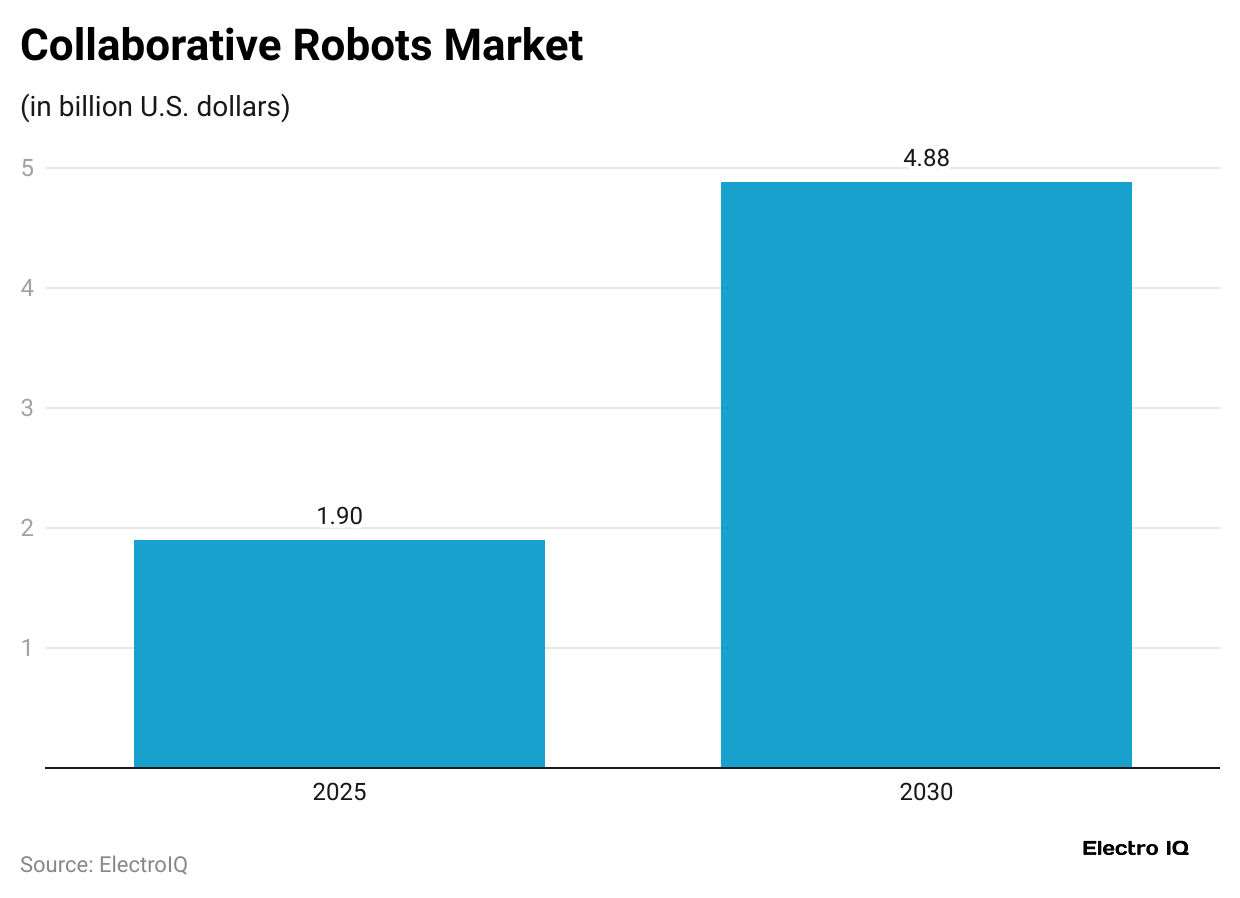
- By the end of 2025, the global collaborative robot market will be valued at around USD 1.9 billion.
- It is expected to grow to USD 4.88 billion by 2030, expanding at a CAGR of 20.76%.
| Metrics | CAGR (From 2024 to 2030) |
| By payload: 10-20 kg unit |
23.8% |
|
By component: Software |
28.2% |
| By application: Palletising and de-palletising |
25.4% |
|
By end-user: Logistics and e-commerce |
31.7% |
By Revenue Analysis
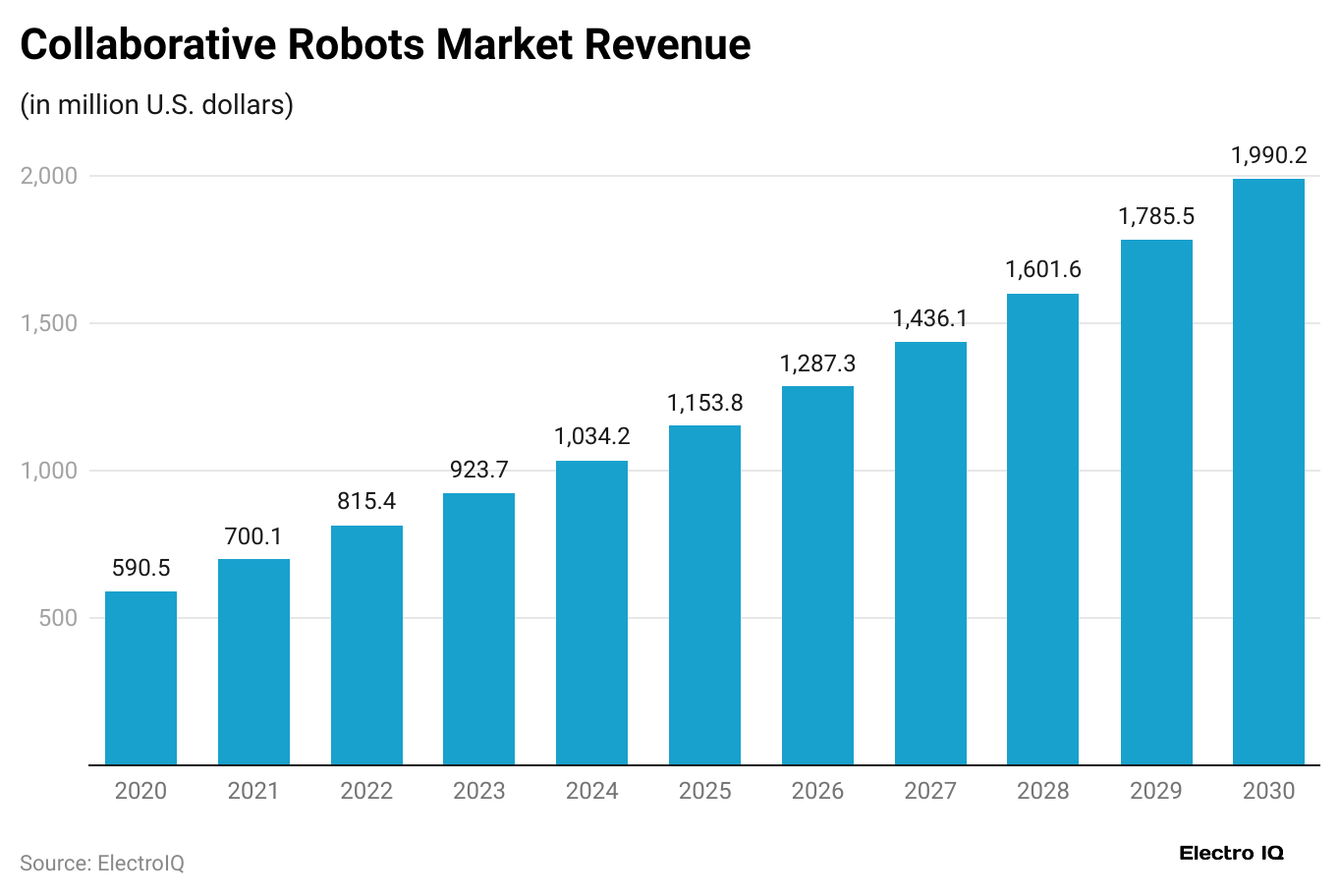
- The above chart shows that the market revenue secured by collaborative robots was USD 1,034.2 million in 2024, rising to USD 1,153.8 million by 2025.
- In the coming years, the estimated revenue is expected to be generated by the market, as follows: 2026 (USD 1,287.3 million), 2027 (USD 1,436.1 million),2028 (USD 1,601.6 million), 2029 (USD 1,785.5 million), and 2030 (USD 1,990.2 million).
By Type Analysis
- A report published by globalgrowthinsights.com states that around 52% of deployed collaborative robots fall under the up to 5 kg payload category.
- 33% of the market is represented by cobots with a payload from 6 kg to 10 kg.
- Nearly 45% of manufacturers in the automotive and metal industries adopt 6 to 10 kg cobots.
- 15% of total installations are in the above 10 kg segment.
- Over 38% of heavy-duty manufacturing plants adopt cobots above 10 kg for lifting and palletising.
By Application
- As of 2024, the automotive sector accounts for over 32% of market share, and around 57% of auto production lines now use cobots for final assembly.
- Electronics account for over 26% of total installations, while more than 60% of circuit board production uses cobots.
- Metal and machining sector: Cobots are used in nearly 18% of fabrication tasks, and approximately 40% of precision machining units use cobots.
- Plastic and polymers represent about 10% of cobot usage, and almost 35% of polymer processors integrate cobots in workflows.
- The food and beverages sector accounts for around 8% of usage, and Cobots are used in over 42% of automated bakery and beverage lines.
- Other sectors (pharma, logistics, healthcare) make up nearly 6% of the market, and over 30% of logistics warehouses use cobots.
By Geographical Analyses
- According to Global Growth Insights, in North America, about 48% of automotive manufacturers used collaborative robots in 2024, while more than 41% of SMEs have adopted them to handle labour shortages and improve efficiency.
- The U.S. leads the regional market with over 55% of total demand, and around 36% of food and beverage processing facilities also use cobots.
- In Europe, collaborative robots account for nearly 30% of global installations, with over 50% of European manufacturers adopting them.
- In Germany specifically, more than 47% of automotive assembly lines employ cobots, and the region records over 44% adoption in precision engineering industries.
- As of 2024, the global share of collaborative robots is 42%.
- In China, the demand of the market accounted for 65%, mostly in automotive and electronics manufacturing.
- Meanwhile, in Japan, cobot was implemented by 40% of electronics assembly plants, and in South Korea,33% of industries depend on collaborative robot integration.
- Lastly, the Middle East and Africa secured a smaller adoption share of 28%.
- Besides, in the Gulf region, almost 35% of industrial warehouses are implemented on collaborative robots mainly for sorting and material handling.
- In contrast, cobot installations remain highest in South Africa, with a demand of 45%.
Collaborative Robots Sales Statistics
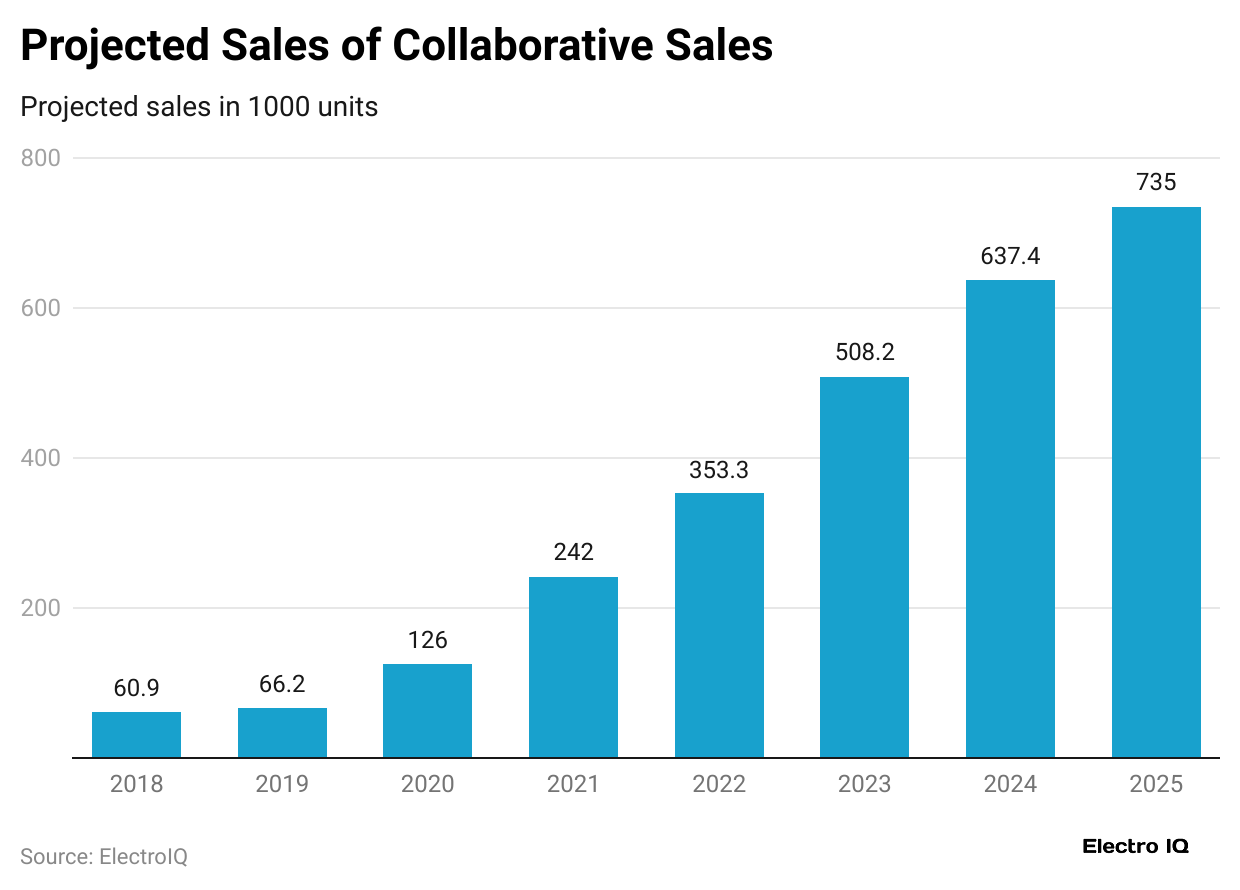
- In 2025, global sales of collaborative robots are expected to reach about 735 thousand units.
- A year earlier, in 2024, the market was projected at 637.35 thousand units, while 2023 saw an estimated 508.2 thousand units.
- Going back to 2022, sales were expected to hit 353.33 thousand units, following a sharp jump in 2021 when sales doubled to 242.03 thousand units.
- In 2020, cobot sales climbed to 126 thousand units, compared with 66.15 thousand units in 2019 and 60.9 thousand units in 2018.
Mobile Collaborative Robots Volume Statistics
- According to market.us, the global mobile cobot market is expanding, with units projected to grow from 8,689 in 2024 to around 11,793 in 2025.
- The expansion is set to accelerate, with projections of 15,778 units in 2026 and 20,758 units in 2027. By 2028, the figure could climb to 26,828 units.
- It also estimated the cobot market volume will reach 34,023 units by 2029, and 42,184 mobile cobots by 2030.
Collaborative Robots Shipment Statistics
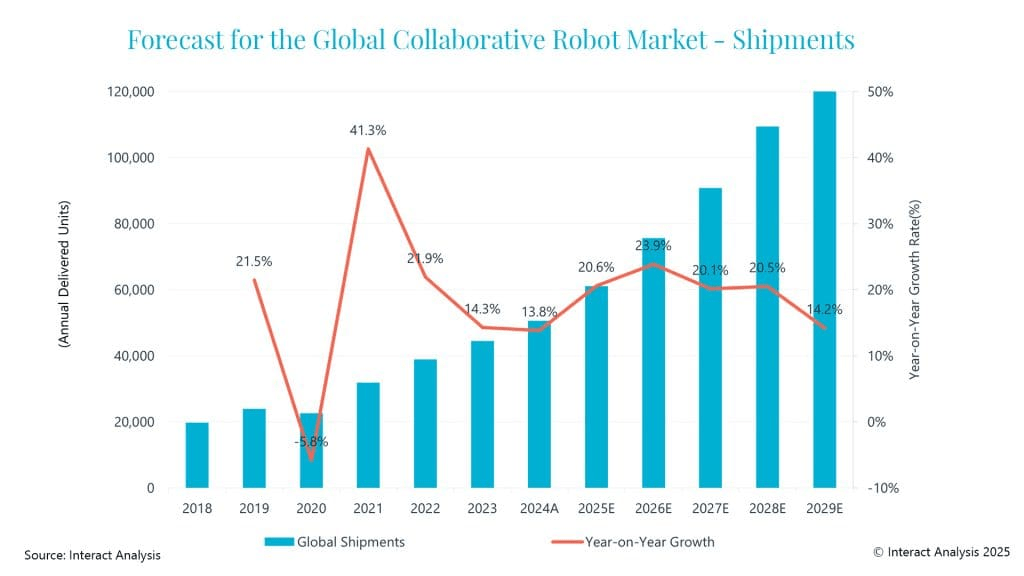
- According to new data from Interact Analysis, cobot shipments grew by 13.8% in 2024, accounting for more than 50,000 delivered units, a decrease from 14.3% Y-o-Y in 2023, resulting in 45,000 units shipped.
Furthermore, in the coming years, the global collaborative robot shipment market is mentioned in the table below:
| Year | Shipment Units (Approx) | Y-o-Y Growth Rate |
| 2025 | 60,000 | 20.6% |
| 2026 | 75,000 | 23.9% |
| 2027 | 90,000 | 20.1% |
| 2028 | 115,000 | 20.5% |
| 2029 | 120,000 | 14.2% |
By Country
| Country | 2024 (Shipment Units) | 2025 Estimated (Shipment Units) |
| China | 18,200 | 22,400 |
| All European Union Countries | 7,000 | 8,430 |
| United States / Americas | 5,250 | 6,327 |
| Japan | 2,800 | 3,375 |
| South Korea | 1,750 | 2,110 |
| Other countries (rest of the world) | 1,000 | 1,570 |
Collaborative Robots Ordered Units Statistics
- A report published by automate.org states that in the first quarter of 2025, North American firms purchased 1,052 collaborative robots worth USD 39.2 million.
- These cobots made up 11.6% of all robot orders and contributed 6.8% of the total revenue during the quarter.
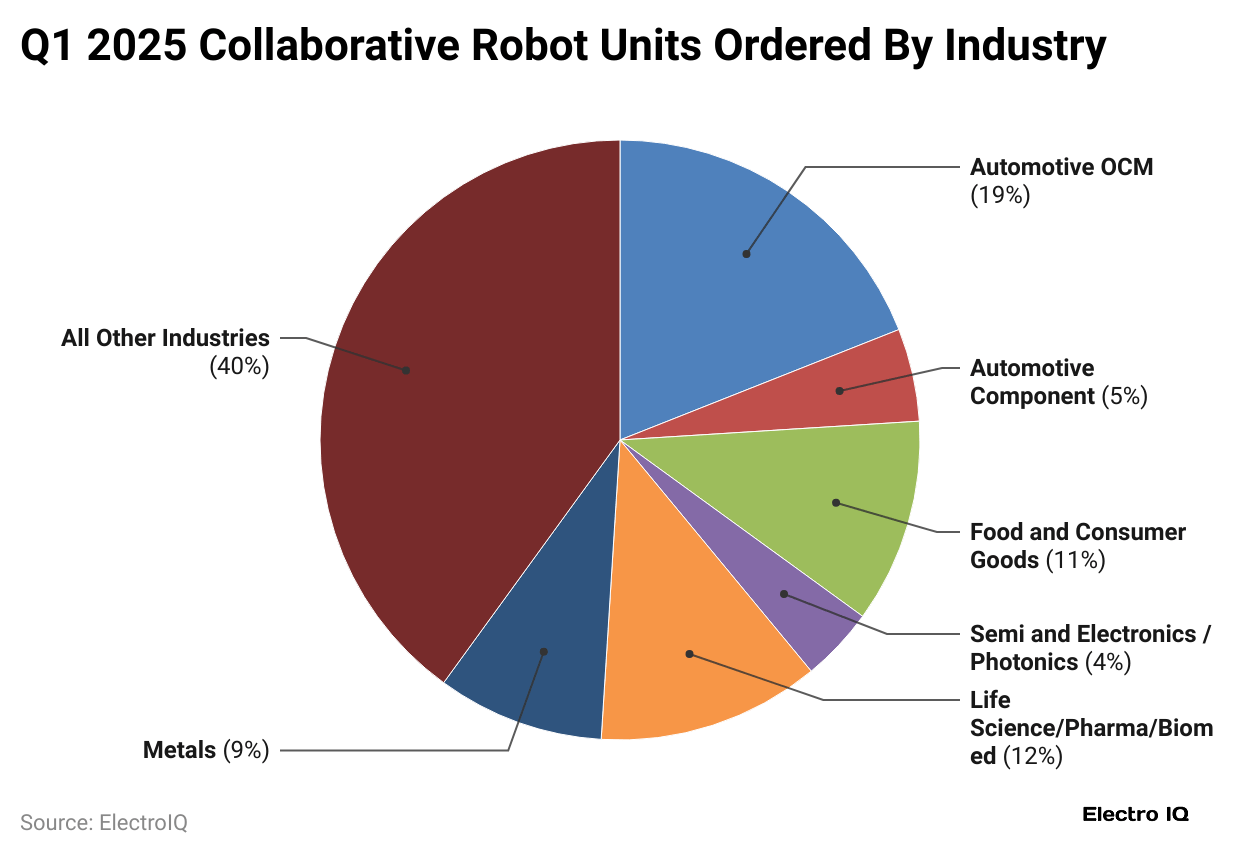
- The maximum collaborative robot was ordered by Automotive OEMs with a share of 19% in Q1 of 2025.
- Moreover, other industries’ order units shares are followed by Life Sciences/Pharma/Biomed (12%), Food & Consumer Goods (11%), Metals (9%), Automotive Components (5%), and Semi & Electronics/Photonics (4%).
- Besides, all other industries secured a unit share of 40%.
Collaborative Robots Cost Statistics
- A collaborative robot typically costs between USD 20,000 and 40,000 and can pay back its investment within 12 to 30 months.
- The electronics and automotive industries increased the adoption, resulting in 55% of the market.
- By the end of 2030, around 70% of manufacturers plan to use cobots, saving about USD 25 per hour in developed countries.
Recent Developments of Collaborative Robots Statistics
- In June 2025, Foxconn announced it would use humanoid robots at its new Houston plant to build Nvidia servers, with production planned to start in early 2026, according to mordorintelligence.com.
- In June, DHL Group expanded its fleet to 7,500 units by partnering with Boston Dynamics to add 1,000 collaborative robots.
- In April, the collaborative robot market reported earnings of about USD 100 million, while in January, Yaskawa saw its profit drop by 12%.
Conclusion
Collaborative robots, once a niche technology, are now vital in many industries. Advances in AI, vision systems, and safety features have made collaborative robots more capable, flexible, and user-friendly, as the adoption rates are steadily rising, along with supporting human workers, improving efficiency, and reducing expenses.
This article includes several statistical analyses from different insights that will guide you effectively in understanding the topic better.
Sources
FAQ.
There are different types of collaborative robots, including Articulated, Selective Compliance Articulated Robot Arm, Cartesian or Gantry, Delta, Mobile / AMRs (Autonomous Mobile Robots), and Cylindrical.
To work safely with humans, automate tasks, boost efficiency, cut costs, and adapt to flexible production requirements across different industries.
The smallest collaborative robot is named Meca500, measuring just 330 millimetres tall.
The largest collaborative robot is the ABB GoFa CRB 15000 with extended reach.
Collaborative robots typically operate at speeds between 250 millimetres and 1 meter per second.

Maitrayee Dey has a background in Electrical Engineering and has worked in various technical roles before transitioning to writing. Specializing in technology and Artificial Intelligence, she has served as an Academic Research Analyst and Freelance Writer, particularly focusing on education and healthcare in Australia. Maitrayee's lifelong passions for writing and painting led her to pursue a full-time writing career. She is also the creator of a cooking YouTube channel, where she shares her culinary adventures. At Smartphone Thoughts, Maitrayee brings her expertise in technology to provide in-depth smartphone reviews and app-related statistics, making complex topics easy to understand for all readers.

